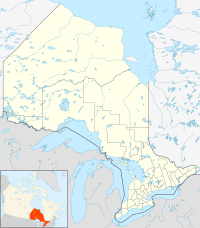Pic Mobert South facts for kids
Quick facts for kids
Pic Mobert South
|
|
|---|---|
| Pic Mobert South Indian Reserve | |
| Country | |
| Province | |
| District | Thunder Bay |
| First Nation | Netmizaaggamig Nishnaabeg |
| Area | |
| • Land | 0.34 km2 (0.13 sq mi) |
| Population
(2011)
|
|
| • Total | 96 |
| • Density | 282.4/km2 (731/sq mi) |
| Website | picmobert.ca |
Pic Mobert South is a special place in Ontario, Canada. It is an Indian reserve, which is land set aside for a First Nation community. This reserve is one of two homes for the Netmizaaggamig Nishnaabeg people, also known as Pic Mobert First Nation. The other home is called Pic Mobert North.
Contents
About Pic Mobert South
Pic Mobert South is a small but important community. It is located in the Thunder Bay District of Ontario. This reserve is where some members of the Netmizaaggamig Nishnaabeg First Nation live.
What is a First Nation?
In Canada, "First Nations" is a term used for the many different Indigenous peoples who lived there before European settlers arrived. Each First Nation has its own history, culture, and traditions. They are an important part of Canada's heritage.
The Netmizaaggamig Nishnaabeg People
The Netmizaaggamig Nishnaabeg are also known as the Pic Mobert First Nation. They are part of the larger Ojibwe (or Anishinaabeg) group of Indigenous peoples. Their traditional lands are in the area around Pic Mobert.
Where is Pic Mobert South located?
Pic Mobert South is found in the northwestern part of Ontario. It is specifically located in the Thunder Bay District. The coordinates for the reserve are 48 degrees 41 minutes North and 85 degrees 39 minutes West. This helps pinpoint its exact spot on a map.
How many people live there?
According to information from 2011, about 96 people lived in Pic Mobert South. The reserve is quite small, covering an area of about 0.34 square kilometers.
Connecting with the Community
The Netmizaaggamig Nishnaabeg First Nation has a website where you can learn more about their community and activities. It's a great way to understand their culture and what life is like on the reserve.


